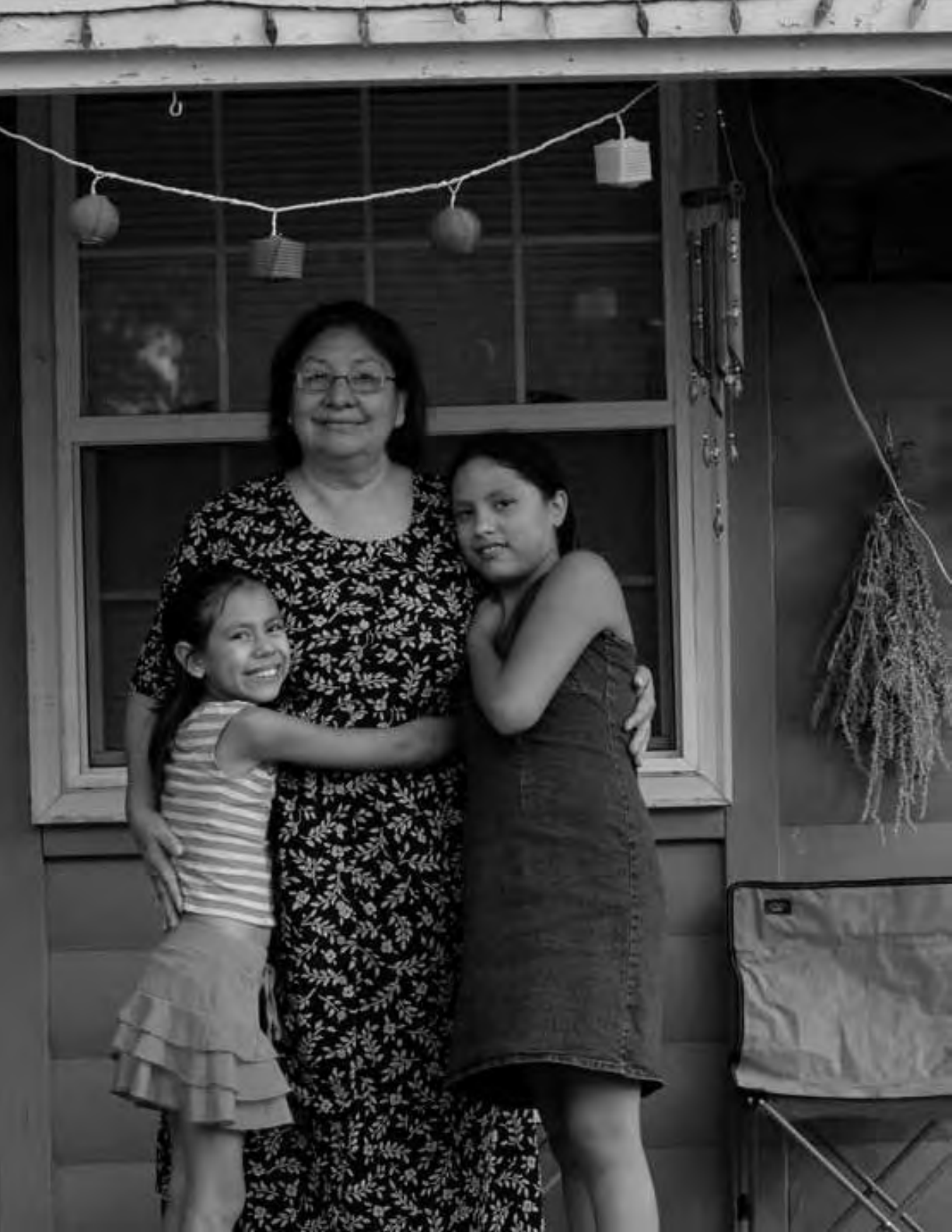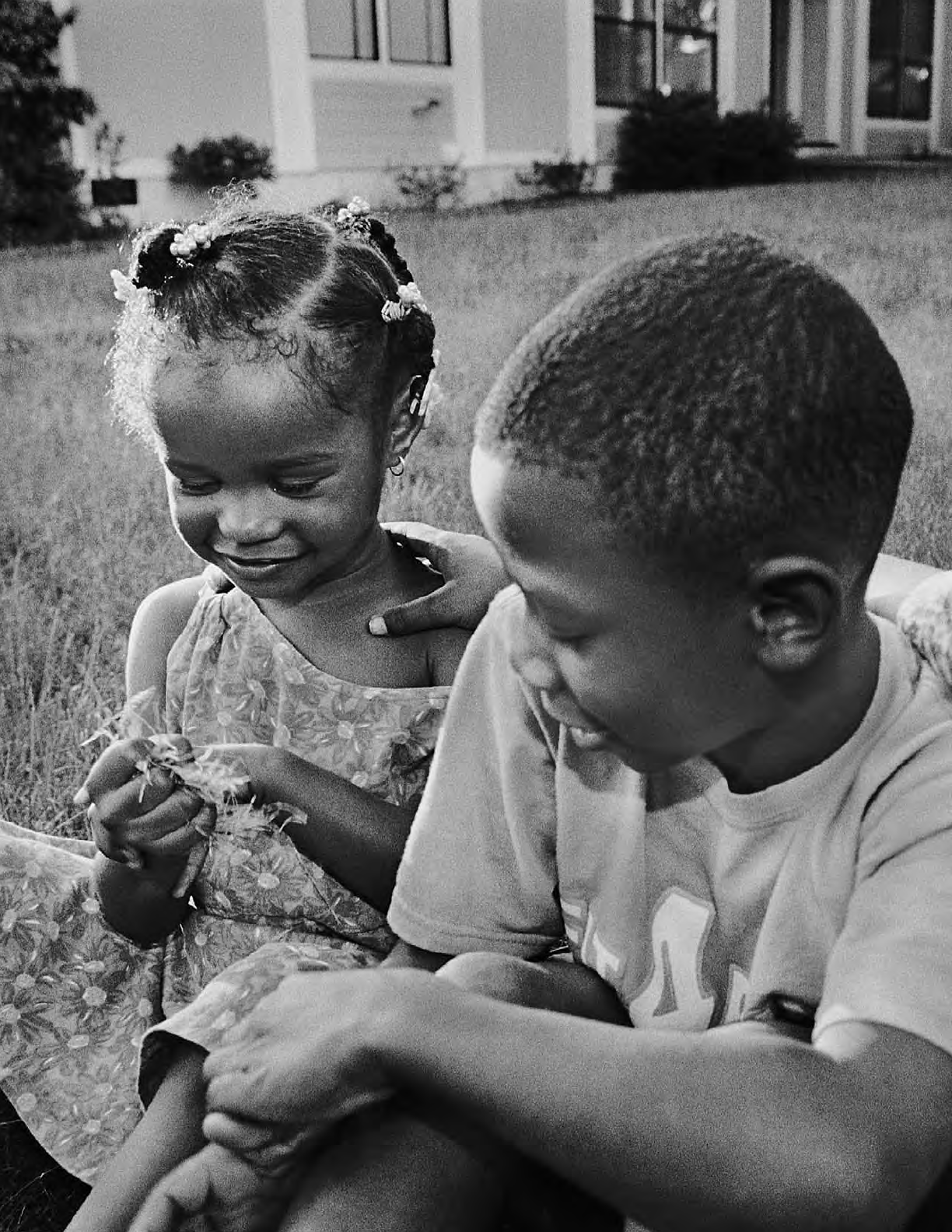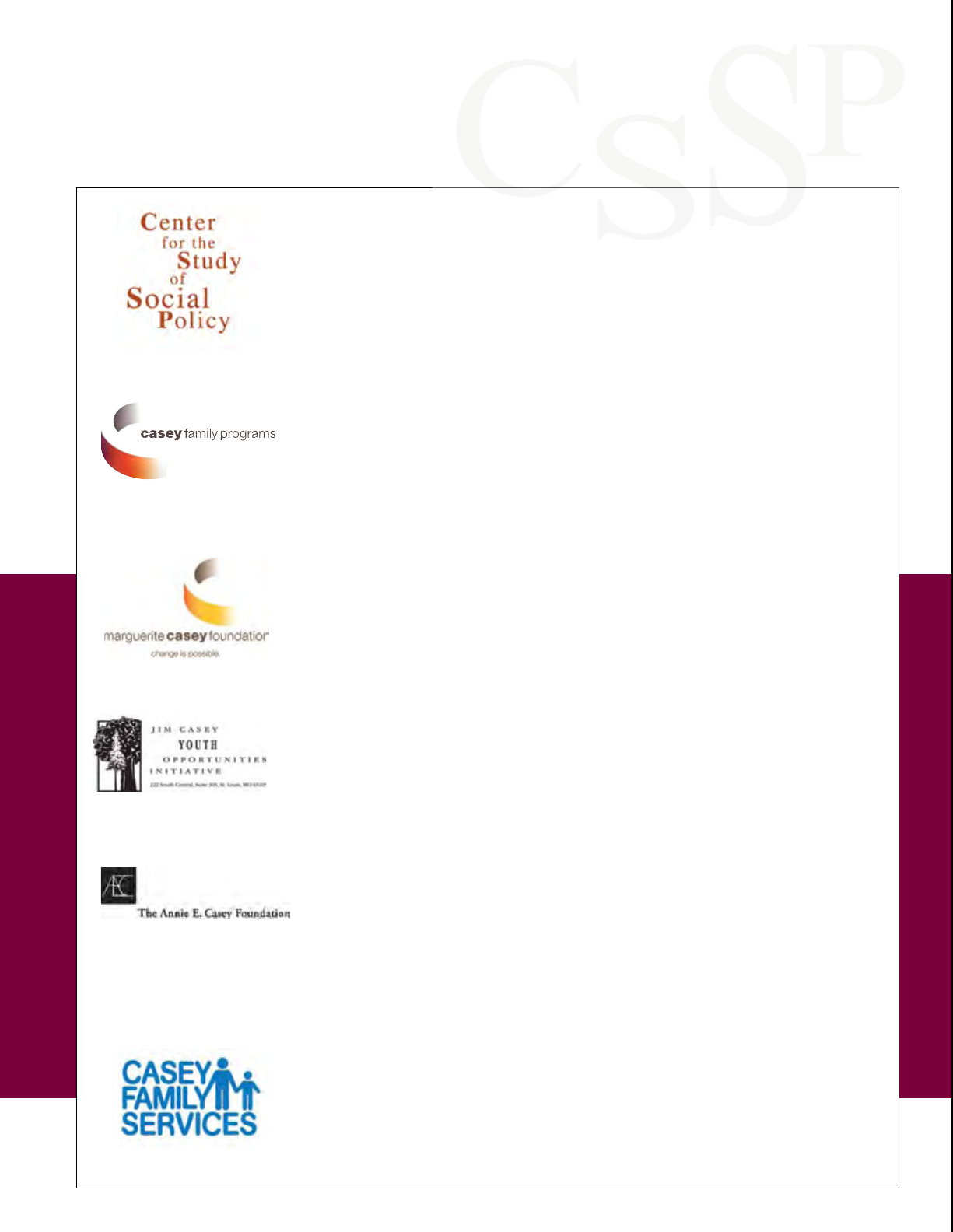
Casey-CSSP Alliance for Racial Equity in Child Welfare
Racial Disproportionality, Race Disparity, and Other
Race-Related Findings in Published Works Derived from
the National Survey of Child and Adolescent Well-Being
by Keesha Dunbar, MBA, MSW
School of Social Work
University of North Carolina, Chapel Hill
Richard P. Barth, PhD
School of Social Work
University of Maryland, Baltimore
CSSP is a nonprofit public policy organization that develops and promotes policies and practices that
support and strengthen families and help communities to produce equal opportunities and better futures
for all children. We work in partnership with federal, state and local government, and communities and
neighborhoods—from politicians who can craft legislation, state administrators who can set and implement
policy and practice, and networks of peers, community leaders, parents and youth to find workable
solutions to complex problems.
Casey Family Programs is the largest national foundation whose sole mission is to provide
and improve—and ultimately prevent the need for—foster care. The foundation draws on its 40 years of
experience and expert research and analysis to improve the lives of children and youth in foster care in two
important ways: by providing direct services and support to foster families and promoting improvements in
child welfare practice and policy. The Seattle-based foundation was established in 1966 by UPS founder
Jim Casey and currently has an endowment of $2 billion.
www.casey.org
The Marguerite Casey Foundation was created by Casey Family Programs in 2001
to help expand Casey’s outreach and further enhance its 37-year record of leadership in
child welfare. Based in Seattle, the Marguerite Casey Foundation is a private, independent
grant-making foundation dedicated to helping low-income families strengthen their voice and
mobilize their communities.
www.caseygrants.org
Jim Casey Youth Opportunities Initiative was created in 2001 by Casey Family
Programs and the Annie E. Casey Foundation. Based in St. Louis, the Initiative is a major national effort to
help youth in foster care make successful transitions to adulthood.
www.jimcaseyyouth.org
The Annie E. Casey Foundation is a private charitable organization dedicated to helping build
better futures for disadvantaged children in the United States. It was established in 1948 by Jim Casey,
one of the founders of United Parcel Service, and his siblings, who named the Foundation in honor of their
mother. The primary mission of the Foundation is to foster public policies, human-service reforms, and
community supports that more effectively meet the needs of today’s vulnerable children and families. In
pursuit of this goal, the Foundation makes grants that help states, cities, and neighborhoods fashion more
innovative, cost-effective responses to these needs.
www.aecf.org
Casey Family Services was established by United Parcel Service founder Jim Casey in 1976
as a source for high-quality, long-term foster care. Casey Family Services today offers a broad range
of programs for vulnerable children and families throughout the Northeast and in Baltimore, Maryland.
The direct service agency of the Annie E. Casey Foundation, Casey Family Services operates from
administrative headquarters in New Haven, Connecticut, and eight program divisions in Connecticut,
Maine, Maryland, Massachusetts, New Hampshire, Rhode Island, and Vermont.
www.caseyfamilyservices.org
Casey-CSSP Alliance for Racial Equity in Child Welfare
318.1-3030-07
Casey-CSSP Alliance for Racial Equity in Child Welfare Racial Disproportionality, Race Disparity, and Other Race-Related Findings in Published Works casey family programs

ABOUT THE ALLIANCE
In 2004, the Casey-CSSP Alliance for Racial Equity in Child Welfare was
established to develop and implement a national, multiyear campaign to
address racial disparities and reduce the disproportionate representation of
children from certain racial or ethnic communities in the nation’s child welfare
system.
The Alliance includes the Annie E. Casey Foundation and its direct service
agency, Casey Family Services, Casey Family Programs, the Jim Casey Youth
Opportunities Initiative, the Marguerite Casey Foundation, the Center for the
Study of Social Policy (CSSP), and parents and alumni of foster care. The
Race Matters Consortium and Black Administrators in Child Welfare (BACW)
are also partners in this work.
The efforts of the Alliance to reduce disparities and the disproportionate
number of children and youth of color in the care of child welfare agencies are
ultimately aimed at improving the outcomes for all children in care by:
• Learning what works to achieve race equity in child welfare services, in
partnership with states and local communities
• Developing and disseminating new knowledge to the field
• Promoting effective federal and state policy through education about policy
options
• Designing and implementing data collection, research, and evaluation
methods that document evidence-based practices and strategies
• Ensuring that birth parents and foster youth and alumni are leaders in
helping child welfare agencies achieve race equity in child welfare services
and programs
For more information, go to www.cssp.org/major_initiatives
/racialEquity.html.
The authors are grateful to Judith Wildfire for reviewing this document and to the
Casey-CSSP Alliance for Racial Equity in Child Welfare for support and commentary,
and to both for suggested improvements.
© 2007 Casey Family Programs

Racial Disproportionality, Race Disparity, and Other Race-Related Findings in Published Works i
TABLE OF CONTENTS
EXECUTIVE SUMMARY ................................................................................................................... 1
INTRODUCTION ..............................................................................................................................
5
CHILD FACTORS ............................................................................................................................
11
Early Childhood Development and Need for Early Intervention ...................................................
11
Developmental Conclusions ......................................................................................................
13
Mental Health and Substance Abuse Treatment Need, Use, and Access ...................................
14
Substance Abuse and Mental Health Conclusions .....................................................................
22
PARENT FACTORS .........................................................................................................................
23
Parental Arrest and Child Involvement with Child Welfare Agencies ............................................
23
Parental Arrest Conclusion ........................................................................................................
25
Domestic Violence: Epidemiology and Services .........................................................................
26
Domestic Violence Conclusion ..................................................................................................
32
REUNIFICATION .............................................................................................................................
35
Reunification Conclusions ..........................................................................................................
38
OVERALL CONCLUSIONS .............................................................................................................
39
REFERENCES .................................................................................................................................
43

ii

Racial Disproportionality, Race Disparity, and Other Race-Related Findings in Published Works 1
EXECUTIVE SUMMARY
This paper draws on peer-reviewed papers and chapters from data gathered during the
National Survey of Child and Adolescent Well-Being (NSCAW) to examine correlates
and contributors to racial disproportionality. NSCAW was commissioned in 1997 by the
Administration on Children, Youth and Families, U.S. Department of Health and Human
Services, to learn about the experiences of children and families who come in contact
with child welfare agency–supervised services. The first national longitudinal study of its
kind, NSCAW is examining the characteristics, needs, experiences, and outcomes for these
children and families.
This report summarizes published and in-press articles and chapters based on the NSCAW
study in order to examine the evidence on the relationship between race/ethnicity and several
important areas related to child welfare and well-being. Topics in this review include:
(1) Child factors and related services, including (a) early childhood development and early
intervention services and (b) mental health and substance abuse treatment need and
access
(2) Parental factors and related services including (a) parental arrest and child involvement
with child welfare services agencies and (b) domestic violence—epidemiology and
services
(3) Reunification and related services
The sample size varies in these studies, as authors have endeavored to select subsamples of
NSCAW that are best suited to answer their question. The CPS sample of NSCAW was
5504
a
children who underwent child maltreatment investigations between November 1999
and April 2001. The sample for each specific analysis, however, may vary due to substantive
or methodological reasons (e.g., whether the analysis is limited to in-home, out-of-home, or
reunified cases, or whether there are missing data on variables to be included in the analysis).
The analyses in these studies were, generally, not intended to isolate the effects of race or
ethnicity on child welfare outcomes or child well-being. All of the studies did, however,
include race and ethnicity in their multivariate models—allowing for an understanding of
whether race and ethnicity was associated with outcomes of interest, above and beyond other
family and child characteristics.
Findings
Overall: Race/ethnicity was not found to be a significant predictor in the receipt of services
for children remaining at home, nor was it an indicator of whether children would be placed
a
After some initial papers and reports were written, three cases were dropped from the study because they
involved participants who were incarcerated and were judged not to have given allowable informed consent.

2
in out-of-home care. Differences were found by race, however, with respect to reunification
and services received.
CHILD FACTORS
Early Childhood Development and Early Intervention Services: What can NSCAW
studies tell us about the relationship between early childhood development needs and service
receipt? The findings show that race and ethnicity are strongly correlated with the overall
level of child welfare involvement and the receipt of services. White children are more likely
to remain at home than to be removed from their homes following the investigation of the
case. Race and ethnicity were also found to be predictive factors in service receipt: Black
children are less likely to receive developmental services than white children, and the racial
inconsistencies in services received remain even after controlling for need.
Mental Health and Substance Abuse Treatment Need, Use, and Access: What can
NSCAW studies tell us about the relationship between race, mental health care services, and
substance abuse treatment need, use, and access? Race/ethnicity accounts for differentials in
overall mental health service use. Specifically, African American and Hispanic children were
more likely to use services than white children even though African American children did
not demonstrate elevated need as a group—that is, their mental health problems were no
greater than other children. In the 6- to 10-year-old age group, however, African American
children showed significant unmet need. They were less likely to receive mental health
services than white children in this age group when other variables were controlled.
Racial/ethnic disparities in mental health service use are also related to the organization of
services. African American and Hispanic children are less likely to receive specialty mental
health services than white children (while holding the county variable constant). In another
study of caregivers, Hispanic caregivers were significantly more likely to receive substance
abuse services, and black non-Hispanic caregivers were significantly less likely to receive
mental health services.
Emotional and behavioral problems for youth and need for mental health treatment were
measured using the Achenbach Child Behavior Checklist (Achenbach, 1991). Interaction
between Achenbach Child Behavior Checklist (CBCL) score and race/ethnicity was found
to be statistically significant: African American children used fewer services than children
of Caucasian ancestry at all values on the CBCL, which suggests lower service use at equal
levels of need. As the CBCL levels increased, the inconsistency in service use was reduced.
Nonetheless, the relative percentage of African American children receiving services was still
smaller. Race/ethnicity (African American versus White) was found to predict outpatient

Racial Disproportionality, Race Disparity, and Other Race-Related Findings in Published Works 3
mental health services use while other variables were constant. This does not suggest the
reason for the non-use of services, only the occurrence.
PA R E N T / FAMILY FA C T O R S
Domestic Violence: What do we know about the relationship between domestic violence,
race, and child welfare system participation from the NSCAW studies? Race was not found
to be a significant predictor in the underidentification of domestic violence in a home.
Race/ethnicity was, however, found to be a significant factor in the continuation of domestic
violence occurrences in a case. Caregiver
b
race or ethnicity was associated with severe physical
violence (relative to no violence) reported at 18 months, with African American women
having approximately twice the odds for reporting severe physical violence compared to
white non-Hispanic women. In addition, African American women who were referred to
child welfare agency–supervised services reported approximately three times greater risk
of experiencing more severe forms of physical violence (e.g., getting beaten up, choked,
threatened with a weapon) compared to white non-Hispanic women when age, marital
status, socioeconomic factors, and other background variables were controlled.
Parental Arrest: What is the relationship between parental arrest, race, and entry into the
child welfare system? NSCAW-related studies have found that parents of African American
children who entered out-of-home care were significantly more likely to have experienced a
recent arrest, and African American children with incarcerated parents were also found to be
overrepresented in the proportion of investigated cases. At the same time, family and child
risk factors identified by child welfare workers (e.g., serious mental illness, active domestic
violence) at the time of intake were lower among African American parents who had been
arrested than among other arrested parents. This suggests that some of the overrepresentation
of entrances into foster care is mediated by police actions in arresting African American
parents and, perhaps, by child welfare agency inaction in developing mechanisms that help
divert children from foster care during parental arrests.
Reunification: What do we know about the relationship between race, reunification,
child’s age, and receipt of services? Findings show that race and reunification have differing
relationships, depending on a child’s age. Overall, for children younger than 7 months and
children older than 10 years of age, racial differences are large; indeed, the greatest racial
variation between predictors of reunification and the outcome of reunification is evidenced
for infants and adolescents.
African American infants are less likely to experience reunification than white infants; in
addition, African American youth over 10 years of age, as well as youth of other racial and
b
The information from the study from which this information was extracted (Connelly et al., 2006) was
taken from permanent caregivers, generally biological family members.

4
ethnic groups over 10, are significantly less likely to return home than white youth. For
youth over 10 years old, the likelihood of reunification continues to be significantly smaller
for children of color compared to white children even when controlling for risk factors, child
behavior, and agency and parent actions. Offsetting the lower risk of reunification for some
age groups are parenting support (for infants) and a higher frequency of seeing mothers
during visits (for children 10 and older).
Summary
A wide array of findings was drawn from the analyses. Some findings suggest that race
and ethnicity effects are related to developmental status or to the organization of mental
health services in the agency, in addition to the potential association with parental arrest.
These findings offer more specificity about how to further understand and address racial
disproportionality. Findings related to parental arrest indicate that African American families
that experience arrest are more common than non-African American families that experience
arrest but have fewer family and child risks, suggesting that child welfare interventions for
African Americans before and after arrest should be developed to address this aspect of their
experience.
Other than this finding, there is a lack of a consistent race or ethnicity effect, suggesting a
continued need to better understand how unfair services to African American children and
families are most likely to arise, e.g., under which circumstances, which children of what age
and with what challenges, and in which families.

Racial Disproportionality, Race Disparity, and Other Race-Related Findings in Published Works 5
INTRODUCTION
Data about service receipt are often difficult to interpret. The meaning of analyses of racial
disproportionality and disparity in child welfare agency-supervised services depends, in
some measure, on the extent to which race and ethnicity seem to be the primary factors in
determining disproportionality or disparity. Alternately, these differences may be attributable
to other co-occurring factors. Both the absence of a race effect and the presence of a race
effect can, at times, be explained by other variables that obscure the true relationship
between race and the particular outcome of interest.
The first of the three most fundamental challenges to interpreting most child welfare
research is determining what “case status” means. That is, whether it is good or bad to
receive a given service (like placement into foster care) may depend on many factors. The
second fundamental problem is that the source of child welfare agency–supervised services
information is generally the child welfare worker, and there is little direct information from
the parent or child. This reliance on a single source of information is a substantial divergence
from the ideals of social science research. The third difficult area of interpretation is that of
explaining the causes of racial disproportionality and disparity. If findings offer explanations
arising from factors that are not evenly distributed among children and families of different
ethnic or racial groups, this leaves open the possible explanations that differences in
outcomes may be attributable to these factors.
The National Survey of Child and Adolescent Well-Being (NSCAW) offers new
opportunities to gain insight into these issues because the study has developmental measures
(not just case status measures) and includes parental self-reporting on parenting behavior and
other health and mental health measures. The study also has many more indicators of family
and child functioning than has ever been available in a child welfare study. In addition,
NSCAW features a national sample that was drawn to be representative of cases investigated
following a child maltreatment allegation. The overall NSCAW sample size for these analyses
is generally 5504 children undergoing child maltreatment investigations between November
1999 and April 2001. The sample for each specific analysis, however, may vary due to
substantive or methodological reasons (e.g., whether the analysis is limited to in-home, out-
of-home, or reunified cases, or whether there are missing data on variables to be included in
the analysis).
Researchers oversampled infants to ensure there would be enough cases going through to
permanency planning. In addition, researchers oversampled for sexual abuse cases (to ensure
that there would be adequate statistical power to analyze this kind of abuse alone) and cases
receiving ongoing services after investigation (to ensure adequate power to understand the
process of services) (Dowd, Kinsey, Wheeless, Suresh, & NSCAW Research Group, 2002).

6
The race/ethnic groups were determined from information provided by the child, caregiver,
or caseworker. When more than one race was reported by a respondent, the rarest race (of
five categories) was assigned based on 1990 U.S. Census data. The race order (from rarest to
most common) was: American Indian/Alaskan Native<Asian/Native Hawaiian/other Pacific
Islander<Black/African American<White<Other (Dowd et al., 2002). In addition, Research
Triangle Institute (RTI) created a derived variable to combine the two separate variables that
defined race and ethnicity. Those who were classified as Hispanic based on the ethnicity
variable (“is the child of Hispanic origin?”: yes/no) were assigned to the Hispanic category
on the combined variable as well. American Indian/Alaskan Native, Asian/Native Hawaiian/
other Pacific Islander, and Other were assigned to the non-Hispanic Other category. The
racial/ethnic groups that will be the focus of the analyses are white, black, and Hispanic/
Latino, because the sample size was too small for Native Americans despite concerns about
racial disparity.
This report summarizes published and unpublished-but-in-press articles and chapters based
on the NSCAW study. Topics in this review include the following:
(1) Child factors and related services including (a) early childhood development and
early intervention services and (b) mental health and substance abuse treatment need
and access
(2) Parental factors and related services including (a) parental arrest and child involvement
with child welfare services agencies and (b) domestic violence—epidemiology and
services
(3) Reunification and related services
In the spring and summer of 2006, we inventoried the published and in-press papers with
these topics, conducted a preliminary reading of those papers to determine whether race and
ethnicity was included in modeling of the dependent measures of concern, and completed
our final selection of 11 articles or chapters and the baseline NSCAW report. (U.S.
Department of Health and Human Services, 2005).
CHILDREN AND CAREGIVERS WITH COMPLETED CWS INVESTIGAT I O N S
Knowledge of the demographics of children and families involved in the child welfare system
is important to understanding the implications of findings on the relationship between race/
ethnicity and service receipt. In the NSCAW sample, which represents the nation’s children
who had completed investigations for maltreatment in the late 1990s (whether or not they

Racial Disproportionality, Race Disparity, and Other Race-Related Findings in Published Works 7
were subsequently substantiated), the racial demographics of these children are as follows:
47% white/non-Hispanic, 28% African American/non-Hispanic, 18% Hispanic/Latino,
and 17% Other. “African American children are overrepresented among children who are
investigated (as compared with children in the general American population).” (NSCAW
Research Group, 2005, pp. 3– 6.) See Table 1.
Setting
In-Home Out-of-Home
Percent/(SE)
Foster
Care
Services
No
Services
TOTAL
In-Home
Kinship
Foster
Care
Total
Race/
Ethnicity
Group
Care
TOTAL
Out-of-
Home
28.1
(2.5)
46.9
(3.7)
18.0
(2.9)
6.9
(0.8)
26.0
(2.6)
47.9
(4.1)
19.3
(3.4)
6.8
(1.0)
30.9
(3/1)
45.4
(3.8)
16.6
(3.1)
7.2
(1.3)
27.3
(2.6)
47.2
(3.7)
18.6
(3.1)
6.9
(0.8)
38.4
(5.6)
38.9
(5.6)
14.9
(4.5)
7.8
(2.2)
33.7
4.3)
47.7
(5.1)
13.1
(3.2)
5.6
(1.8)
18.0
(5.9)
61.9
(9.5)
12.0
(4.5)
8.1
(3.9)
34.6
(3.8)
44.8
(4.1)
14.0
(2.8)
6.7
(1.4)
African
American
White
Hispanic
Other
Table 1
Characteristics, Living Situations, and Maltreatment of Children Involved with the Child Welfare
System: Age, Gender, Race/Ethnicity, and Setting of Children Entering the Child Welfare System
(Weighted)
Note: Percentages are based on weighted data; standard errors are in parentheses. Source: U.S. Department of
Health and Human Services Administration for Children and Families, 2005, p. 62.
In addition to examining the racial breakdown of children and families involved with
child welfare agency–supervised services, it is also important to review the race/ethnic
contributions in service receipt and placement. Table 1 also depicts the simple bivariate
relationship between race/ethnicity and service receipt (those who either received no services,
those where cases were closed at intake, or those who received in-home services); and the
comparison of in-home versus out-of-home care (NSCAW Research Group, 2005). Race/
ethnicity was not found to be a significant predictor in the receipt of services for children
remaining at home, nor was it an indicator in whether children would be placed in out-of-
home care (NSCAW Research Group, 2005).
Another important factor to examine is the racial breakdown of current caregivers (in-
home and out-of-home) of the children in the study: 51% of the caregivers are white/non-

8
Hispanic; 26% are African American/non-Hispanic; 17% are Hispanic; and 7% are classified
as being of Other race/ethnicity (Table 2). The NSCAW report also included information
on the correspondence between race/ethnicity of the foster caregivers and children in their
care (NSCAW Research Group, 2005). See Table 3. Most (92%) white children were placed
with a self-identified white caregiver, whereas only two-thirds (66%) of African American
children were placed with a self-identified African American caregiver. Among the one-third
of African American children not identified as placed with an African American caregiver,
about half were placed with a caregiver identified as white. For Hispanic children, only 42%
were placed with a caregiver self-identified as Hispanic.
Note: Children in group care and other types of care were eliminated from these analyses because there were
multiple caregivers but only one was interviewed; therefore, determining a “match” between caregivers and
children was not possible. Source: U.S. Department of Health and Human Services Administration for
Children and Families, 2005, p. 209.
Setting
In-Home Out-of-Home
Percent/(SE)
Foster
Care
Services
No
Services
TOTAL
In-Home
Kinship
Foster
Care
Total
Race/
Ethnicity
Group
Care
TOTAL
Out-of-
Home
25.5
(2.7)
51.4
(2.7)
16.3
(3.3)
6.8
(1.0)
23.5
(2.9)
51.2
(4.3)
17.6
(4.0)
7.8
(1.3)
28.4
(2.9)
51.2
(3.8)
15.4
(3.0)
5.0
(0.8)
24.8
(3.4)
51.2
(3.8)
17.0
(3.5)
7.0
(1.1)
24.0
(2.8)
51.2
(3.8)
13.2
(7.0)
5.8
(1.6)
29.6
(4.0)
56.8
(4.7)
9.2
(2.2)
4.4
(1.1)
51.9
(12.2)
41.3
(11.4)
X
X
30.9
(3.6)
53.9
(5.2)
10.4
(3.5)
4.8
(0.9)
African
American
White
Hispanic
Other
Table 2
Current Caregiver Demographics by Service Setting

Racial Disproportionality, Race Disparity, and Other Race-Related Findings in Published Works 9
Note: Bold numbers indicate that the caregiver is the same race/ethnicity as the child. Children in group care
and other care are excluded. Source: U.S. Department of Health and Human Services Administration for
Children and Families, 2005, p. 210.
Race/Ethnicity of Current Caregiver
Race/
Ethnicity of Child
African American
-
Percent (SE)
Hispanic Percent
(SE)
White Percent
(SE)
Other Percent
(SE)
65.5
(6.0)
3.3
(1.2)
3.6
(1.6)
4.7
(2.2)
16.0
(4.7)
92.4
(2.0)
48.5
(20.5)
42.4
(9.4)
13.4
(7.2)
2.9
(1.3)
42.0
(21.0)
9.1
(5.5)
5.1
(2.9)
2.4
(1.1)
2.7
(2.0)
31.4
(7.9)
African
American
White
Hispanic
Other
Table 3
Non-kinship Foster Care: A Comparison of the Child to Caregiver Race/Ethnicity

10

Racial Disproportionality, Race Disparity, and Other Race-Related Findings in Published Works 11
CHILD FACTORS
Early Childhood Development and Need for Early
Intervention Services
OVERVIEW AND METHODS
Identification of early child development needs and the receipt of related early intervention
services is an important topic in the child welfare arena. Children involved in the child
welfare system often have a higher level of developmental and behavioral need than those
who are not. Minimal research exists that examines the relationship between race and
ethnicity and the need and receipt of services within the child welfare population. There is
one published NSCAW article related to early childhood development and the need for early
intervention services that includes race and ethnicity as a predictor of service use (Stahmer,
Leslie, Hurlburt, Barth, Webb, & Landsverk, et al., 2005). The purpose of that study was
to determine the level of developmental and behavioral need in young children entering
the child welfare system, to determine the level of early intervention services use, and to
observe variation in need and service use based on age and level of involvement in the child
welfare system. This article does not solely focus on the relationship between early childhood
development and the need for early intervention services and race/ethnicity, although it does
include race/ethnicity in the analysis.
Participants. The sample for that study focused specifically on 2,813 children who were
6 years of age and younger from the study sampling frame. The cohort included children
from birth to 14 years of age at the time of sampling who had contact with the child welfare
system during a 15-month period that began in October 1999. The racial/ethnic mix of
the sample was 29 percent African American, 47 percent white, 19 percent Hispanic, and 5
percent Other.
Procedure. Field representatives performed several interviews with caregivers regarding the
children in their care in order to assess the child directly. Assessments were conducted at
an average of 5.3 and 13.2 months after onset of the child welfare investigation. Children
included in that article were between 1 and 71 months of age at the time of the first
interview.
Measures. Sociodemographic information was collected regarding the child’s age, gender,
and race/ ethnicity. The level of child welfare system involvement and the history of alleged
maltreatment of children were both obtained from child welfare agency workers. Workers
were asked to identify the types of maltreatment that had been alleged by using a modified
maltreatment-classification scale. Measures were obtained in five areas to estimate the risk for
developmental and behavioral problems in young children and the need for early intervention

12
services. Comprehensive screening assessments were used to measure developmental/cognitive
status, which varied with the age of the child. The language and communication level was
assessed in order to determine the possibility of language delay, using the Preschool Language
Scales. In order to understand behavioral needs, the Child Behavior Checklist (CBCL) was
used. Social skills were measured in children 3 to 5 years of age by using the Social Skills
Rating Scale (SSRS). Adaptive behavior was measured using the Vineland Adaptive Behavior
Scale screener. Measures were categorized into five domains for analyses: developmental/
cognitive status, adaptive behavior, behavior problems, communication, and social skills.
Service use information regarding whether a child had received any services was obtained
from interviews with current caregivers.
MAJOR FINDINGS IN RELAT I O N T O R A C E / E T H N I C I T Y
In a simple bivariate comparison, race/ethnicity was found to be related to the overall level of
child welfare system involvement (p <.01). Children remaining at home were more likely to
be white than children removed from their homes.
c
This was true for in-home cases that were
opened to child welfare agency–supervised services as well as for those that were not open.
Children remaining at home with an open case were less likely to be Hispanic than children
removed from their homes (all differences were at the p < .05 level). Differences in child
welfare services received were also strongly associated with maltreatment type.
Service Use. A multivariate analysis determined the relationship between race/ethnicity and
service use in the mental health, education, or primary care sectors. Age, race/ethnicity, and
level of risk were significantly related to service use. Over all, a strong relationship was shown
between developmental risk and service receipt: Children with two areas of developmental
and behavioral risk were five times as likely to receive services (p ≤ .001). Younger children
were less (OR=.33) likely to receive services (p < .001). To summarize:
The level of child welfare system involvement was also found to predict
service use; children living at home, regardless of whether they had an
active case, were much less likely to receive services for developmental or
behavioral problems than children living in out-of-home care; children at
home without an active case were the least likely to receive services.
(Stahmer et al., 2005, p. 896.)
Race/ethnicity was also found to be associated with service use; it was determined that black
children were about half as likely to receive services as white children: OR = 0.44 (0.25, 0.79;
p < .05). Stahmer et al. (2005) also found this difference to be consistent at the various levels
c
This finding appears to run counter to the earlier finding that there was no difference in the placement by
race, suggesting that the finding stated, here, might be an age-related finding.

Racial Disproportionality, Race Disparity, and Other Race-Related Findings in Published Works 13
of risk especially when two risk factors were present. While the reasons for these differences
were not addressed in their study, the authors did find that the racial inconsistencies in
services received remained even after controlling for need. (See Table 4.)
Source: Stahmer et al., 2005, p. 897.
Developmental Conclusions
The findings show that race and ethnicity are strongly correlated with the overall level of
child welfare system involvement and the receipt of services. White children are more likely
to remain at home than to be removed from their homes when a child welfare case is opened.
Race and ethnicity were also found to be predictive factors in service receipt: Black children
are less likely to receive services than white children and the racial inconsistencies in services
received remained even after controlling for need.
PSE
B
Coefficient
1.02
1.64
– 1.10
– 0.82
– 0.27
Odds Ratio
(95% Confidence
Interval)
0.32
0.36
0.2
0.29
0.41
2.76 (1.47, 5.19)
5.18 (2.54, 10.58)
0.33 (0.22, 0.50)
0.44 (.025, 0.79)
0.76 (0.33,1.74)
0.001
0.000
0.0173
Developmental and behavioral need
(ref = no risk)
1 risk score
≥ 2 risk scores
Age (ref = 3–5 y)
0–2y
Race/ethnicity (ref = white/nonHispanic)
Black/non-Hispanic
Hispanic
Table 4
Logistic-Regression Analysis of Any Service Use (Educational, Mental Health, or Primary Care)
According to Model Variables (N=2813)

14
Mental Health and Substance Abuse Treatment Need, Use,
and Access
OVERVIEW AND METHODS
Four NSCAW articles address mental health and substance abuse diagnosis, treatment, or the
access to mental health services. These four articles are cited within this review (Burns et al.,
2004; Hurlburt, et al., 2004; Leslie, Hurlburt, Landsverk, Barth, & Slymen, 2004; Libby,
Orton, Barth, & Burns, 2007). None of these articles focused their examination on the
relationship between substance abuse and treatment or the access to mental health services
on the one hand, and the race/ethnicity of children or parents on the other. Each of them
did include race/ethnicity in their analysis, however. Moreover, Burns et al. (2004) identified
factors related to the need for and use of mental health services among youth, with special
attention to differences by age groups (3–5, 6–10, and 11+), at the time of entrance into
NSCAW.
Participants. The sample was limited to children ages 2 years and above (N=3,803) to
correspond to age-related measures of mental health need. 29.6% of the sample included in
these analyses fell into the preschool group (2 to 5 years), 41.9 in the school age group (6
to 10 years), and 28.6% in the adolescent group (11 to 14 years). The racial demographics
of the sample consisted of 47.6 percent white, 28 percent African American, 17.5 percent
Hispanic , and 7 percent members of other racial/ethnic groups.
Procedure. Logistic regression was used to examine variables associated with service use.
Demographic variables were included in all models. Clinical need measures and the nature
of available services varied due to the presence of multiple informants; separate models were
estimated by age group.
Measures. Burns et al. report that:
Emotional and behavioral problems for youth and need for mental health
treatment was measured using the Child Behavior Checklist (CBCL); the
Youth Self Report (YSR); and the Teacher’s Report Form (TRF). Data on
the use of mental health services in the 12 months preceding the survey
interview are based on an adapted version of the Child and Adolescent
Services Assessment (CASA). A modified Maltreatment Classification Scale
(Manly et al., 1994) was used to identify the types of maltreatment alleged
in the most recent report using emotional abuse, and neglect. Youth were
categorized as being in one of four possible living situations at the time
of the investigation: (1) with their permanent primary caregiver, typically

Racial Disproportionality, Race Disparity, and Other Race-Related Findings in Published Works 15
a parent; (2) non-relative foster care; (3) kinship foster care; or (4) group
home/residential treatment center. Child welfare workers identified family
risk factors based on the information/knowledge available to them at the
time of the case investigation. (Burns et al., 2004.)
MAJOR FINDINGS IN RELAT I O N T O R A C E / E T H N I C I T Y
In order to understand disparity in mental health service receipt, logistic models were used
to examine factors related to service use across the three age groups (see Table 5). “While
controlling for other factors, children across all age groups scoring in the clinical range on
the CBCL were 2.5–3.6 times more likely to receive mental health services.” (Burns et al.,
2004, p. 965.)
*p < .01; **p < .001. Source: from Burns et al., 2004, Table 2, p. 965.
Demographic Characteristics
Table 5
Multivariable Logistic Regression Models of Past-Year Mental Health Service Use by Youth (Ages
2–15) Who Were Subjects of Investigated Reports of Maltreatment (N = 3,211)
Ages 2– 5
(N=970)
Ages 6– 10
(N=1,274)
Ages 11– 14
(N=971)
Selected Variables
OR 95% CI OR 95% CI OR 95% CI
Child age (continuous)
African American (versus white)
Hispanic (versus white)
Other (versus white)
Male (versus female)
1.3
.5
.8
3.0
1.9
.9 – 1.7
.2 – 1.2
.3 – 2.3
.8 – 10.9
.9 – 4.3
1.0
.4*
.6
.3
.8
.9 – 1.2
.2 – .8
.2 – 1.8
.1 – .8
.5 – 1.4
.9
.7
1.4
1.0
1.2
.8 – 1.2
.3 – 1.4
.7 – 2.9
.2 – 4.1
.7 – 2.1
Clinical range CBCL
(64 and above versus below 64)
3.5* 1.3 – 9.5 2.9** 1.6 – 5.2 2.7* 1.5 – 5.1
Placement
In-home (versus out-of-home)
.6 .3 – 1.5 .4** .2 – .6 .4* .2 – .7
Parental Risk Factors
Parent severe mental illness
Impaired parenting skills
Parent physical impairment
Monetary problems
2.0
.6
2.8
1.2
.5 – 8.6
.3 – 1.5
.9 – 8.5
.5 – 2.8
1.6
.8
.7
1.4
.8 – 3.0
.4 – 1.5
.3 – 1.9
.7 – 2.9
2.4*
1.3
.8
1.3
1.3 – 4.3
.6 – 2.6
.4 – 1.9
.7 – 2.2

16
In summary, African American youth did not demonstrate elevated need as a group—that
is, their mental health problems were no greater than other children—but they did show
significant unmet need among the 6- to 10-year-old age group, and they were less likely
to receive mental health services than white youth in this age group when other variables
were controlled. For African American youth age 6–10, the OR = .4 (.2,.8) p <.01 and for
school-age children and adolescents living at home, the OR = .4 (.2,.6) p <.001, indicating a
significantly reduced likelihood of receiving mental health care.
The second study in this group endeavored to further understand the disparity in care for
children from ethnic communities (Hurlburt et al., 2004). Specifically, this study examined
how patterns of specialty mental health service use among children involved in the child
welfare system vary as a function of the degree of coordination between local child welfare
and mental health agencies.
Participants. This article focused specifically on children in NSCAW who were removed
from their homes or were living in a family in which a case was opened for child welfare
agency supervised services after substantiation of abuse or neglect (N=2823). The racial/
ethnic mix of the study’s participants was 33% African American, 47% white, 13%
Hispanic, and 7% members of other groups.
Procedures. This study uses data from initial interviews with child welfare workers and
initial and 12-month follow-up interviews with current caregivers. County-level data were
also collected from agency informants by trained research assistants.
Measures. Hurlburt et al. reported:
Sociodemographics and placement information were collected and classified
from study participants. The child welfare worker identified the types of
suspected maltreatment using a modified Maltreatment Classification Scale
(Manly et al., 1994). For each case in the NSCAW, caseworkers reported
the presence or absence of risk factors that resulted in the family having
contact with child welfare. The Child Behavior Checklist (CBCL) was used
to estimate emotional and behavioral problems for youth and the need for
mental health treatment. Current caregivers responded to questions about
children’s mental health service use in an adapted version of the Child and
Adolescent Services Assessment. The strength of linkages existing between
child welfare and mental health agencies at the local level was assessed
through 2 different interview modules, one focusing on mental health
services available to children in the child welfare system and one focusing

Racial Disproportionality, Race Disparity, and Other Race-Related Findings in Published Works 17
on characteristics of the local mental health agency in the county. Regional
variation in specialty mental health provider supply was estimated. Variables
that describe the child population size and the level of poverty in the county
were included as control variables in multivariate models. Hurlburt et al., 2004.
MAJOR FINDINGS IN RELAT I O N T O R A C E / E T H N I C I T Y
Multivariate models were used to predict the relationship between specialty mental health
service use and each of the child- and family-level predictors (see Table 6). Hurlburt et al.
(2004) found the interactions of CBCL score with the strength of interagency linkages
(between the local child welfare and mental health service systems), in addition to the
interaction of race/ethnicity with interagency linkages to be significant. Race/ethnicity
accounted for differentials in service use; specifically, African American children were
0.61 times as likely and Hispanic children were about half as likely to use services as
white children.
Bold OR (CI) =p<.05. Source: Hurlburt et al., 2004, p. 1222.
Racial/ethnic disparities in service use are also related to the organization of services. African
American and Hispanic children are less likely to receive specialty mental health services than
white children (while holding the county variable constant).
Yet, linkages between child welfare and mental health moderated the
relationship between race/ethnicity and service use with the effect primarily
focused on service use patterns by African American children; OR = 0.15
Table 6
Multivariable Logistic Regression Models of Specialty Mental Health Service Use During One Year
Race/Ethnicity
Step 1:
Child and Family
Predictors
(N=2275)
Step 2:
County-Level Control
Variables Added
(N=2182)
Step 3:
Provider Supply and
Linkage Variables Added
(N=2099)
African American
Other
Hispanic
White
β
– 0.50
– 0.68
– 0.43
1.00
OR (CI)
.61 (.39 – .94)
.51 (.28 – .93)
.65 (.36 – 1.17)
β
– 0.49
– 0.62
– 0.36
1.00
OR (CI)
.61 (.38 – .97)
.53 (.30 – .96)
.70 (.38 – 1.29)
β
– 1.91
– 0.84
– 0.74
1.00
OR (CI)
.15 (.03 – .63)
.43(.07 – 2.52)
.48 (.13 – 1.75)

18
(0.03– 0.63); p < 04. In counties with stronger child welfare/mental health
linkages, differentials in service use between African American children and
white children diminished. As linkage levels increase, differences in rates of
service use between white and African American children diminish;
OR = 1.12 (1.01, 1.25). Hurlburt et al., 2004, p. 1223.
The authors believed that the coordination of services between child welfare and mental
health agencies, as it relates to the mental health needs of children, may be able to prevent
disparities in mental health care use among African American children.
In order to estimate the prevalence and severity of family mental health and substance
abuse problems, and the impact on children involved with child welfare systems and their
caregivers, the third study measured the co-occurrence of caregiver alcohol, drug, and mental
health (ADM) problems with children’s behavioral problems (Libby, Orton, Barth, & Burns,
2007). Understanding whether this level of co-occurrence varies by race and ethnicity could
be important to culturally and racially competent service planning.
Participants. Analyses presented were limited to children who were 2 to 14 years of age
baseline in the core NSCAW sample. Interviews were completed at baseline and at 18
months to collect data from the child, current caregiver, and the child welfare worker. In
order to keep data consistent, only children with caregivers who were constant between
baseline and 18 months were included in these analyses (N=1,876).
Procedure. Logistic regression was used to: (1) estimate relationships between baseline
child and caregiver characteristics and caregiver ADM problems, (2) estimate relationships
between child and caregiver risk factors and caregiver service receipt for substance use
problems at 18 months, and (3) estimate relationships between child and caregiver risk
factors and caregiver service receipt for mental health problems at 18 months (Libby
et al., 2007).
Measures. The Composite International Diagnostic Interview-Short Form (CIDI-SF)
was used to interview caregivers at baseline in order to assess substance dependence (drug
or alcohol dependence separately) and occurrence of a major depressive episode. At the
time of investigation, child welfare workers assessed caregiver risk factors for substance
use and emotional problems; the youth were not given standardized interviews, however.
Consequently, the Child Behavior Checklist (CBCL) was used to estimate emotional
and behavioral problems for youth and the need for mental health treatment. A modified
Maltreatment Classification Scale was used to identify types of maltreatment. At 12 and
18 months, the child welfare worker was asked questions regarding referrals made for each

Racial Disproportionality, Race Disparity, and Other Race-Related Findings in Published Works 19
OR
3.40
1.32
---
(95% CI)
(2.26, 5.10)**
(0.71, 2.43)
---
OR
0.98
0.40
0.30
1.00
(95% CI)
(0.39, 2.46)
(0.11, 1.42)
(0.12, 0.76)*
---
OR
3.22
0.92
0.51
1.00
(95% CI)
(1.34, 7.72)**
(0.32, 2.60)
(0.17, 1.54)
---
caregiver and services received by the caregiver since the last interview. Subsequent action was
taken depending upon the status of the referral or service receipt (Libby et al., 2007).
MAJOR FINDINGS IN RELAT I O N T O R A C E / E T H N I C I T Y
Table 7 presents results from the multivariate logistic regression model; only children whose
caregiver had a baseline ADM problem (40%) were included in these models. Libby et al.
(2007) found that there was no significant difference between the caregiver’s race/ethnicity
and the caregiver’s ADM problems at baseline. In further analysis, the study estimated the
likelihood of service receipt for substance use and mental health problems by the caregiver
between baseline and 18 months. The study found that Hispanic caregivers were significantly
more likely to receive substance abuse services (OR=10.96 (3.32, 36.17), p<0.01), and
black/non-Hispanic caregivers were significantly less likely to receive mental health services
(OR=0.23 (.72, 8.7), p <0.001).
Child had clinically significant (>= 64) CBCL at baseline
Table 7
Predicting Baseline Caregiver ADM Problems and Wave 3 Caregiver ADM Service Receipt with
Baseline Child ADM Problems and Baseline Caregiver Risk Factors
Externalizing
Internalizing
Child in-home at baseline
Out-of-home at baseline
Caregiver ADM
problem at baseline
Caregiver received
services for substance
problem at Wave 3
1
Caregiver received
services for mental
health problem
at Wave 3
1
Child’s age (years)
1.79
1.18
1.00
1.11
0.24
2.82
1.00
0.99
(1.04, 3.10)*
(0.79, 1.74)
---
(0.71, 1.77)
(0.07, 0.83)*
(0.88, 8.99)
---
(0.39, 2.56)
(0.71, 5.95)
(0.43, 2.11)
---
(0.22,0.94)*
2.06
0.95
1.00
0.45
2 – 5
6 – 10
11 – 14
Child’s gender (female)
Table 7 continued on next page.
* p < .05; ** p < 0.01
1
Only caregivers with an ADM problem at baseline were included in this model.

20
Caregiver race/ethnicity
Black/non-Hispanic
Hispanic
Other
White/non-Hispanic
1.39
0.81
0.83
1.00
2.51
10.96
2.02
1.00
(0.80, 2.40)
(0.43, 1.57)
(0.35, 1.99)
---
(0.72, 8.70)
(3.32, 36.17)**
(0.50, 8.14)
---
(0.11, 0.51)**
(0.34, 4.91)
(0.12, 2.47)
---
0.23
1.29
0.53
1.00
* p < .05; ** p < 0.01
1
Only caregivers with an ADM problem at baseline were included in this model.
Source: Libby et al., 2007, Table 6–3, p. 115
The final study on mental health service needs and use determined whether interactions
between clinical and non-clinical factors, specifically race/ethnicity and abuse type, affect
service use among children in foster care (Leslie, Hurlburt, Landsverk, Barth, & Slymen,
2004).
Participants. A group of children were specifically selected for this study to represent
children who had been in out-of-home placement for approximately 12 months at the time
of sampling, termed the “One Year in Foster Care” (OYFC) sample (N=1, 291). More than
half (56%) of this sample had caregiver interviews completed. The racial demographics
of the sample included 37% Caucasian, 39% African American, 16% Hispanic, and 8%
Other. In addition, 57% of children were placed in nonrelative foster care, followed by 33%
placements in kinship and 11% placements in group homes.
Procedure. Caregivers and children were interviewed if permission was granted. Interview
data were entered directly into computers by the field representatives. The sample of children
selected for this study had been living with their current caregiver for an average of 17.84
months. What’s more, 71.5% of the child/caregiver sample matched on reported race/
ethnicity.
Measures. Sociodemographics and placement information were collected and classified
from the study’s participants. The child welfare worker identified the types of suspected
Table 7 continued from previous page.
OR OR(95% CI) (95% CI) OR (95% CI)
Caregiver ADM
problem at baseline
Caregiver received
services for substance
problem at Wave 3
1
Caregiver received
services for mental
health problem
at Wave 3
1
N
1413 745 745

Racial Disproportionality, Race Disparity, and Other Race-Related Findings in Published Works 21
maltreatment using a modified Maltreatment Classification Scale. For each case in the
NSCAW, caseworkers reported the presence or absence of risk factors that resulted in the
family having contact with child welfare. The Child Behavior Checklist (CBCL) was used
to estimate emotional and behavioral problems for youth and the need for mental health
treatment. The use of mental health services was measured using an adapted version of the
Child and Adolescent Services Assessment (CASA). The current study included information
on the use of outpatient and residential services since the time of the investigation leading to
the current out-of-home placement (Leslie et al., 2004).
MAJOR FINDINGS IN RELAT I O N T O R A C E / E T H N I C I T Y
In the multivariate analysis examining the use of outpatient mental health service, race/
ethnicity was found not to be a significant factor related to service use; when comparing
African American children to white children, however, African-Americans were OR = .34
times as likely to access services (95% CI .14, .86).
In additional multivariate analyses, the study investigated whether the level of need
(according to CBCL score) for services differed by race/ethnicity of the child, after applying
statistical controls to account for other differences. The authors found that the interaction
between CBCL score and race/ethnicity was statistically significant using a likelihood ratio
test. In addition, African Americans used fewer services than children of white ancestry at
all values on the CBCL. The authors ran a regression analysis with an interaction term with
CBCL as a continuous variable by race/ethnicity; the African American by CBCL score
interaction term was significant at p < .01, while other racial/ethnic groups’ interactions
were found not to be significant. AfricanAmerican youths were less likely to access services
compared to whites when CBCL scores were lower. As the levels increased, the inconsistency
in service use decreased. Nonetheless, the quantity of African American children receiving
services remained smaller than the number of white children receiving services.
While all other variables in the regression model were held constant, race/ethnicity (African
American versus white) was found to predict outpatient mental health services use.
This finding may represent expanded use of services by Caucasian children
at lower CBCL scores—i.e., more preventive interventions—or constrained
use of services by African-American children. However, given that a CBCL
score of 64 or greater represents the 98th percentile with respect to need for
services, the authors anticipate that this finding reflects unmet need.
(Leslie et al., 2004, p. 708.) This paper did not assess factors that contributed to limiting
access to services for African American children.

22
Substance Abuse and Mental Health Conclusions
These studies of mental health and substance abuse treatment strengthen previous findings
that children in foster care have high rates of need and that race/ethnicity is associated with
less access to mental health services. African American children were significantly less likely
to use services than white and Hispanic children (Hurlburt et al., 2004) unless they were
in well-coordinated service systems. Although African American children did not display
elevated need as a group or diminished services as a group, African American youth age 6–10
should receive special attention as they were found to have a significantly reduced likelihood
of receiving mental health care versus other races in their age group (Burns et al., 2004).
When examining the relation of race/ethnicity to receipt of mental health services by
caregivers, Libby et al. (2007) found that black non-Hispanic caregivers were significantly
less likely to receive mental health services than other races. Leslie et al. (2004) found race/
ethnicity not to be a significant factor in outpatient mental health service receipt, however.
Leslie et al. also found that race/ethnicity (African American versus white) was a predictor of
outpatient mental health services use even while other variables were held constant. Further
analysis must be conducted in order to truly understand the racial disparities in service need
and receipt, but these studies offer some important new insights into these dynamics.

Racial Disproportionality, Race Disparity, and Other Race-Related Findings in Published Works 23
PARENT FACTORS
Parental Arrest and Child Involvement with Child Welfare
Agencies
OVERVIEW AND METHODS
Impact of parental arrest on service use has long been discussed in the literature (e.g., Pelton,
1991; Shireman, Miller, and Brown, 1981); however, there is a lack of detailed information
regarding ways that race and ethnicity may be related to the overlapping responses to
parental arrest within the child welfare population.
One NSCAW article related to parental arrest and children involved with child welfare
services agencies is that of Phillips, Barth, Burns, and Wagner, 2004 (previously cited in this
review). This study provided the first national estimate of parental arrest among children
who are the subjects of reports of maltreatment investigated by child welfare agencies. The
article also compared the relationship between arrested parents of different racial/ethnic
groups in the analysis.
Participants. The sample for this study focused specifically on children who were the
subjects of reports of maltreatment investigated by child welfare agencies. The sample of
5,504 children selected from completed case investigations/assessments forms the basis
for the present analyses.
d
Approximately half the children were white (46.1%), and about
one-quarter were African American (28.4%); smaller proportions were Hispanic children
(18.4%) or children of other racial/ethnic groups (3.8%).
Procedure. The children, from birth to age 15, were selected to take part in the NSCAW
survey between October 1999 and December 2000. Approximately 11% of the children
were in out-of-home placements. Boys and girls were equally represented.
Measures. The recent arrest of a parent was determined through two sources of information:
the child welfare worker’s and a parent’s reports. Child welfare workers were asked to
identify parent risk factors that existed at the time of the case investigation and the types
of maltreatment that had been alleged using a modified Maltreatment Classification Scale
(Manly, Cicchetti, and Barnett, 1994). Regarding the type of placement, children were
categorized as being in one of five possible living situations:
(a) with the person who was their permanent primary caregiver, typically their parent, at the
time of the investigation
d
In some research, the sample is identified as 5501, because three parents were interviewed in prison and their
data was later removed. Also, some published and in-press NSCAW papers make reference to investigations/
assessments because there were a few states that had already begun to implement an alternative response
system, and in these states, the investigation was called an assessment.

24
(b) with relatives
(c) in non-relative foster care
(d) in institutional placements (e.g., residential treatment and group homes)
(e) “other”
The Child Behavior Checklist (CBCL; Achenbach, 1991; Achenbach & Rescorla, 2000),
completed by the primary caregiver of children age 2 years and older, was used to estimate
clinically significant emotional and behavioral problems.
MAJOR FINDINGS IN RELAT I O N T O R A C E / E T H N I C I T Y: PARENTA L A R R E S T A N D
PLACEMENT IN OUT-OF-HOME CARE
Race and ethnicity have a significant association with variation in the rates of parental
arrest, which, in turn, has a significant association with placement into foster care. African
American children with incarcerated parents were found to be overrepresented in the
proportion of investigated cases with a recent arrest. Yet the risk factors identified by child
welfare workers at the time of intake were lower among African American parents who
had been arrested than among other arrested parents. Thus, African American parents who
are arrested may have less cumulative risk than other arrested parents. This suggests that
some of the overrepresentation of entrances into foster care is mediated by police actions in
arresting African American parents and, perhaps, child welfare agency inaction in developing
mechanisms that help divert children from foster care during parental arrests.
Race and ethnicity had a significant relationship (p <.001) to the variation in the rates of
parental arrest. Approximately 12.5% of the children assessed for maltreatment by child
welfare agencies had parents who had recently been arrested. African American children with
incarcerated parents were overrepresented in this sample; only 28% of African American
children were subjects of maltreatment reports, but they constituted 43% of the children
with arrested parents (see Table 8). In contrast, Hispanic children were underrepresented;
Hispanic children comprised approximately 18% of the investigated maltreatment reports
but only represented 10% of children whose parents had experienced incarceration. Last, it
was found that the proportion of all arrests involving whites is considerably higher (69.7%)
than the proportion of arrested white parents in this study. Nearly one in every five African
American children (19.9%) in the sample had a parent who had been recently arrested—this
was double the rate for white children and about four times the rate for Hispanic children
and children from other races and ethnicities. Compared with other children who come to
the attention of child welfare agencies, those with arrested parents are significantly more
likely to be in out-of-home care.

Racial Disproportionality, Race Disparity, and Other Race-Related Findings in Published Works 25
Note. Values are weighted percentages. Source: Phillips et al., 2004, p. 178.
Parental Arrest Conclusion
Parents who were arrested had a greater number of risk factors (e.g., impaired parenting,
serious mental illness, trouble meeting basic needs, active domestic violence, and substance
abuse). Other notable factors, although not statistically significant, were that:
[T]he rate of four parental risk factors (i.e., impaired parenting, physical
impairment (at the level of a trend), trouble meeting basic needs, and
substance abuse) were lower among African American parents who had
been arrested than among other arrested parents. Arrested African American
parents also were different from non African American parents in that they
had the fewest children over age 11 (14.6%) and the highest rate of prior
reports of maltreatment (76.3%). Further, reported rates of emotional
maltreatment (9.8%) were lowest and reported rates of failure to supervise
(54.2%) and sexual maltreatment were highest among arrested African
American parents relative to other arrested parents (11.6%). (Phillips et al.,
2004, p. 181).
Race/
Ethnicity of Child
Yes
TOTALNo
43.1
42.6
10.5
3.8
26.1
46.7
19.8
7.5
28.4
46.1
18.4
7.1
African American
White
Hispanic
Other
Table 8
Comparison of Demographic Characteristics of Children Whose Parents Were or Were Not Arrested
(N=5,322)
Recent Parental Arrest
Significance: F(2.4, 217.4) = 10.1, p<.001

26
Domestic Violence: Epidemiology and Services
OVERVIEW AND METHODS
The overlap between domestic violence and child welfare agency-supervised services has
long been known and increasingly documented. Yet relatively little attention has been given
to ways that race and ethnicity may be related to the occurrence, and response to, domestic
violence within the child welfare population. We cite NSCAW articles related to domestic
violence in addition to information found in the ACF report: Connelly, Hazen, Coben,
Kelleher, Barth, and Landsverk, 2006; Hazen, Connelly. Kelleher, Barth, and Landverk,
2006; Hazen, Connelly, Kelleher, Landsverk, and Barth, 2004; Kohl, Barth, Hazen, and
Landsverk, 2005. None of these articles focused their examination on the relationship
between domestic violence and race/ethnicity, although each of them included race/ethnicity
in their analysis.
A pair of articles examined the underlying epidemiology of domestic violence within the
child welfare population: Hazen et al., 2004 and Hazen et al., 2006. The purpose of these
studies was to determine the prevalence and correlates of intimate partner violence among
female caregivers of children reported to child protective services in addition to determining
the relationship between intimate partner violence and child behavior problems.
Participants. The analyses presented in these papers are limited to the core child protective
services sample (N=5,504) of the NSCAW study. These analyses included children who
were not in out-of-home placement at the time of the baseline interview. Among these
4,037 cases, 3,612 (89.5%) had baseline interviews with a female caregiver in which data on
intimate partner violence were obtained. The samples vary slightly along racial/ethnic lines
but consist of approximately 27% African American individuals, 49% white individuals,
17% Hispanic individuals, and 7% individuals of other racial/ethnic groups.
Procedure. Information about child and caregiver mental health, service use, and family
environment information was obtained from caregiver interviews. Child welfare workers
were interviewed regarding initial case investigation and prior contact with child protective
services.
Measures. Researchers gathered demographic and background information was gathered
from caregivers on a range of demographic characteristics. The following scales were used
during assessment in this study respectively: The Conflict Tactics Scales (CTS1) was used
to assess information regarding intimate partner violence and the physical violence scale was
employed to assess caregivers’ experiences with intimate partner violence; the World Health
Organization Composite International Diagnostic Interview Short-Form was used to assess

Racial Disproportionality, Race Disparity, and Other Race-Related Findings in Published Works 27
mental health and substance use issues of the caregiver; the Child Behavior Checklist (CBCL)
was used to assess child behavior problems; and the physical health scale of the Short-Form
Health Survey (SF-12) was used to assess the physical health of the caregiver. (Hazen et al.,
2004, pp. 305–306).
MAJOR FINDINGS IN RELAT I O N T O R A C E / E T H N I C I T Y
NSCAW Research Group (2005) stipulated that several characteristics (i.e., gender, types
of maltreatment, etc.) of children who were placed in out-of-home care were comparable to
those who remained at home. Hazen et al. (2004) found that
[D]espite these general findings it cannot be concluded that the children
who were in out-of-home care have families with similar incidence or
intensity of intimate partner violence as the children described in this paper.
In fact, the presence of intimate partner violence in the home may have
influenced some child protective services caseworkers to place children in
out-of-home care.” (Hazen et al. [2004], p. 304.)
Hazen et al. (2006) found that the use of corporal punishment (p <.05) and psychological
aggression (p =.05) in the presence of severe intimate partner violence were significant
moderators in child behavior problems and had some relationship to race/ethnicity. Hispanic
children were likelier to have lower externalizing scores compared with non-Hispanic white
children (B = – 2.67; p < .05). Black children had the lowest externalizing scores relating to
aggressive and delinquent behavior; race was not found to be significantly associated with the
internalizing behavior of children.
Another study provides further understanding of the intersection of domestic violence,
child welfare, and race/ethnicity. In this study, information was obtained about whether
child welfare workers recognized domestic violence in the home during the investigative
process for maltreatment (Kohl et al., 2005). This study also endeavored to determine the
factors associated with the child welfare worker’s underidentification of domestic violence
in cases; the level of domestic violence services use over the 18-month period following
the investigated maltreatment; how the caseworker’s identification of domestic violence
compared to caregiver self-report of domestic violence victimization; and the factors
associated with referral and receipt of domestic violence services.
Participants. Analyses for this study involved the permanent female caregivers (N=3135)
of children remaining in the home following allegations of maltreatment. Caregivers were
included in the study regardless of the outcome of the child maltreatment investigation. This

28
allowed for comparisons between caregivers in families who did and did not receive child
welfare services. Families receiving ongoing services had some level of follow-up contact with
the child welfare agency following the investigation, while those without services did not. In
this sample of female caregivers of children remaining at home, 27% received child welfare
services and 73% did not get those services. The sample consisted of 25% African American
individuals, 51% white individuals, 17% Hispanic individuals, and 7% individuals of other
racial/ethnic groups.
Procedures. The indicators for domestic violence used in this study came from two
sources: child welfare worker interviews and caregiver interviews. Face-to-face interviews
were conducted with the permanent caregiver of children remaining in the home, with or
without child welfare services, at baseline and at 18 months. The child welfare worker also
participated in a face-to-face interview at baseline, 12 months after, and 18 months after the
investigation.
Measures. The child welfare worker was given a risk assessment instrument to complete
for each caregiver at the time of entrance into the system to determine if active domestic
violence toward the caregiver was present and if there was a history of domestic violence
in the home. Domestic violence services data were also collected from the caregiver and the
child welfare worker. Following the questions about domestic violence victimization on
the caregiver interview, the women were asked about domestic violence services. When a
referral was made, a follow-up question inquired as to whether the referral resulted in the
receipt of services. Through the data analysis approach, descriptive statistics were calculated
on demographic characteristics of the overall sample and for caregivers who did and did
not report domestic violence victimization within the 12 months preceding the baseline
interview. Next, analyses were conducted to identify the level of agreement between caregiver
report of domestic violence and child welfare worker report of domestic violence. The rates
for sensitivity and specificity were determined. Logistic regression analysis was then used to
examine the factors influencing the underidentification of domestic violence by the worker.
Each case received a cumulative risk score, and analyses focused on active or recent domestic
violence because this is a more likely predictor of current need for domestic violence services
(Kohl et al., 2005).
MAJOR FINDINGS IN RELAT I O N T O R A C E / E T H N I C I T Y
The study focused on female caregivers of children remaining in the home following the
investigation (N=3,165). Within this sample, there were no significant differences by race
or ethnicity, poverty level, education, or presence of spouse or other intimate partner in the
home.

Racial Disproportionality, Race Disparity, and Other Race-Related Findings in Published Works 29
The study found that while child welfare workers indicated that active domestic violence was
present in only 12% of families investigated for maltreatment, 31% of caregivers reported
domestic violence victimization in the past year. Underidentification occurred in nearly a
quarter of the families—the worker did not identify domestic violence when the caregiver
had reported domestic violence in 22% of the cases. Race was not, however, found to be a
significant predictor in the underidentification of domestic violence services.
When examining factors associated with the referral to domestic violence services and the
receipt of these services, African American women involved with domestic violence may be
less likely than other women to be referred for domestic violence services; OR = .46 (2.0,
1.1), although the differences are not statistically different at p < .05.
Another NSCAW study also examined the longitudinal course of intimate partner violence
among female caregivers of children receiving child welfare agency-supervised services in
order to further examine the correlation between domestic violence, child welfare, and race/
ethnicity (Connelly et al., 2006).
Participants. The sample was comprised of 1,153 female caregivers for whom data on
intimate partner violence were obtained at baseline and who reported a history of physical
intimate partner violence in the previous 12 months; 861 participants within this sample
provided data at the 18-month follow-up. The racial/ethnic mix of the sample was 24%
African American, 53% white, 16% Hispanic, and 7% other.
Procedure. Demographic information, child and caregiver mental health status, and family
environment (including experiences with intimate partner violence) were obtained from
caregivers’ interviews.
Measures. Demographic and background information was gathered from caregivers on a range
of demographic characteristics. The CTS1 Physical Violence Scale was employed to assess
caregivers’ experiences with intimate partner violence. This measure was divided into Minor
and Severe subscales, based on the severity of the violent act. The caregiver’s mental health
and substance use (e.g., major depression, alcohol dependence, and drug dependence) were
assessed with screening scales from the World Health Organization Composite International
Diagnostic Interview Short-Form. The community environment was measured using the
abridged Community Environment Scale. Caregivers responded to questions on social
support and related family resources adapted from the Duke–University of North Carolina
Functional Social Support Scale and the Sarason Social Support Questionnaire. The analyses
focused on the cessation or continuation of severe and minor physical violence victimization
reported in the preceding 12 months (participants were interviewed at 18 months post-
baseline) (Connelly et al., 2006).

30
MAJOR FINDINGS IN RELAT I O N T O R A C E / E T H N I C I T Y
The most important predictors of nonresponse at the 18-month follow-up included
insurance coverage of the child, the relationship of the caregiver to the child at baseline,
type of abuse and neglect, sampling strata, baseline caregiver being unemployed, child
race or ethnicity, urbanicity of the primary sampling units, case substantiation (whether
services were arranged for or provided for a family who contacted child protective services to
investigate), and level of severity of risk to child (whether caregiver had serious mental health
problems, a recent history of arrests, or intellectual or cognitive impairments). In all cases,
none of the variables reviewed had statistically significant bias.
Racial or ethnic background was an important factor in female caregivers’ risk for intimate
partner violence victimization. As shown in Table 9, caregiver race or ethnicity was associated
with severe physical violence (relative to no violence) reported at 18 months with African
American women having approximately two times the odds for reporting severe physical
violence compared to non-Hispanic white women.

Racial Disproportionality, Race Disparity, and Other Race-Related Findings in Published Works 31
Reference
2.08
1.44
Reference
.27 to 16.05
.43 to 4.78
Reference
0.4781
0.5514
Reference
6.78
13.4
Reference
1.28 to 35.95
2.01 to 89.50
Reference
0.025
0.008
No partner in
household at baseline
and 18 months
Partner in household
at both baseline and
18 months
Partner in household
at either baseline or
18 months
Reference
e
2.35
0.95
Reference
.66 to 8.41
.36 to 2.52
Reference
0.186
0.9243
Reference
1.97
1.23
Reference
.59 to 6.59
.37 to 4.06
Reference
0.2694
0.7359
0.98 .92 to 1.04 0.4923 1.02 .95 to 1.08 0.6459
Severe physical violence/
no physical violence (past year)
OR CI p
Less severe physical violence/
no physical violence (past year)
OR CI p
Non-Hispanic White
Table 9
Polychotomous Logistic Regression Predicting Severe and Minor Interpersonal Violence at 18
Months by Race or Ethnicity
Variables
Caregiver age
(continuous)
e
The value of reference variables was used as the point of comparison for other values.
f
Intimate partner violence.
No partner in
household at baseline
and 18 months
Partner in household
at both baseline and
18 months
Partner in household
at either baseline or
18 months
Intimate Partner in Household
Reference
2.82
Reference
1.20 to 6.64
Reference
0.0184
Reference
0.48
Reference
.21 to 1.11
Reference
0.0845
Less severe
Severe
Intimate Partner Violence at Baseline
f
0.97 .90 to 1.04 0.3427 0.9 .82 to .99 0.0297
African American
Caregiver age
(continuous)
Intimate Partner in Household
Reference
0.89
Reference
0.19 to 4.23
Reference
0.8774
Reference
1.13
Reference
.027 to 4.67
Reference
0.8644
Less severe
Severe
Intimate Partner Violence at Baseline
Table 9 continued on next page.

32
Source: Connelly et al., 2006, pp. 789–790.
The correlates of intimate partner violence victimization differed across racial or ethnic
groups (see Table 9). White women who reported severe intimate partner violence at baseline
had nearly three times the odds for reporting severe violence at 18 months relative to women
who reported only minor violence at baseline. White women also tended to have lower odds
for reporting less serious violence at 18 months. African American women who were living
with a partner at both baseline and 18 months or who were living with a partner at either
of these time points had significantly greater odds for experiencing minor violence at 18
months.
Domestic Violence Conclusion
The current findings show that underidentification of domestic violence by child welfare
workers is still a prevailing issue; the percentage of domestic violence cases reported by
caregivers continues to exceed those recognized by child welfare workers. Race was not,
however, found to be a significant predictor in the underidentification of domestic violence
services (Kohl, 2005).When examining children’s externalizing scores, Hazen et al. (2006)
Table 9 continued from previous page.
Reference
1.47
6.91
Reference
0.11 to
20.40
.53 to 89.56
Reference
0.7725
0.1374
Reference
1.88
0.75
Reference
.41 to 8.64
.09 to 6.11
Reference
0.4152
0.7822
1.15 1.01 to 1.32 0.0345 0.91 .78 to 1.06 0.2114
Severe physical violence/
no physical violence (past year)
OR CI p
Less severe physical violence/
no physical violence (past year)
OR CI p
Hispanic
Variables
Caregiver age
(continuous)
No partner in
household at baseline
and 18 months
Partner in household
at both baseline and
18 months
Partner in household
at either baseline or
18 months
Intimate Partner in Household
Reference
1.1
Reference
.10 to 11.59
Reference
0.9348
Reference
1.06
Reference
.24 to 4.69
Reference
0.9368
Less severe
Severe
Intimate Partner Violence at Baseline

Racial Disproportionality, Race Disparity, and Other Race-Related Findings in Published Works 33
found that Hispanic children were more likely to have lower externalizing scores compared
with non-Hispanic white children while black children had the lowest externalizing scores
relating to aggressive and delinquent behavior.
Race/ethnicity was found to be a significant factor in the onset of domestic violence cases.
Connelly et al. (2006) found that white women were more likely than other races to report
severe violence at baseline; however, they were less likely to report less severe violence at 18
months. African American women living with a partner were significantly more likely to
experience minor violence and were two times more likely to report severe physical violence
compared to non-Hispanic white women at 18 months.

34

Racial Disproportionality, Race Disparity, and Other Race-Related Findings in Published Works 35
REUNIFICATION
OVERVIEW AND METHODS
NSCAW offers the opportunity to further test the relationship between reunification
and race using more information about parents and children. To date, only one study
(the NSCAW) has addressed issues related to reunification and race, although this was
not the focus of the study. Wildfire, Barth, and Green (2007) examined the likelihood of
reunification following the first out-of-home placement episode for study children with
reunification defined as “returning to own home” within 18 months.
Participants. Among the study children 1,568 children, from birth to age 14, entered out-
of-home placement at least one time prior to 18 months. At the 18-month data collection
mark, 30% of these children had returned to their own home (the subjects in the analysis
described below) with an additional 8% having exited out-of-home placement to live with
a relative. The sample consisted of 41% white children, 36% black children, 17% Hispanic
children, and 6% other race/ethnicites.
Procedures. Wildfire et al. (2007) divided case characteristics that might predict
reunification into three categories: child-specific characteristics, familial risk factors, and
agency or parent actions following the referral.
Measures. Wildfire et al. described the measures ot this study as follows:
Cox Proportional hazard models were used to test the relationship
between child, family and agency characteristics and actions and the
rate of reunification. Hazard ratios were then calculated (HR) for each
parameter entered into the model. The HR estimates the comparative
rate of reunification for children with different characteristics. Covariate
were included in the model to calculate the HR while controlling for
the relationship of other child and family characteristics to reunification.
(Wildfire et al., 2007).
MAJOR FINDINGS IN RELAT I O N T O R A C E / E T H N I C I T Y B Y A G E
The results of Cox regression models presented in Table 10 reveal that race and reunification
have differing relationships, depending on a child’s age. African American infants (birth to 6
months) are significantly less likely to be reunified by 18 months (HR = .42; p>.05); so, too,
are African American youth older than 10 (HR = .14, p < .01).

36
^
.42*
**
.24**
6.74**
5.4***
Birth – 6 months
1
Table 10
Significant Results (HR) from Multivariate Analysis of Reunification Rate by Child’s Age at Baseline
Race (reference = white)
African American
Abuse type (reference = physical abuse)
Failure to provide/supervise
Parenting support (reference = none)
Compliance with case plan (reference = compliance with none/some)
Significant Variables HR
1.78^
4.47***
7 months – 2 years
2
Male
Compliance with case plan (reference = compliance with none/some)
4.21*
*
.13**
29.69^
6.03*
3 – 5 years
3
Male
Abuse type (reference = physical abuse)
Sexual abuse/other
Cumulative risk (reference = high risk)
Compliance with case plan (reference = compliance with none/some)
.53*
4.53*
49.90***
6 – 10 years
Substance abuse
Initial kin placement (reference = initial placement not kin)
Other, borderline/clinical
**
.14**
.13**
2.0^
**
3.33*
4.76*
Over 10 years
4
Race (reference = white)
African American
Other
Placed in new neighborhood (reference = placed in new neighborhood)
Frequency seeing mom (reference = never)
< 1 time per week
1 time per week or more
Source: Wildfire et al., (2007), Table 9–3. p. 164.
1
Other variables in the final model for children less than 7 months old included child’s gender, child’s race,
trouble paying basic expenses, parental substance abuse.
2
Other variables in the final model for children between the ages of 7 months and 2 years included child’s race,
parental substance abuse, trouble paying basic expenses, level of cumulative risk for family, initial placement
with kin.
Notes on Table 10 continued on next page.

Racial Disproportionality, Race Disparity, and Other Race-Related Findings in Published Works 37
3
Other variables in the final model for children between the ages of 3 and 5 years included child’s race, CBCL
score.
4
Other variables in the model for children over 10 years included child’s gender, CBCL score, self-reported
delinquency score, initial placement with kin, compliance with case plan.
^
.05 < p <=.10 , * .01 < p <= .05, ** .001 < p <= .01, *** p <=.001
When controlling for child characteristics, family risk factors, and agency and parent actions,
the racial disparity in reunification disappears for children 7 months through 2 years and 3
to 5 years. However, since these analyses target reunification by 18 months specifically and
do not include other exits from care, this finding should not be understood as indicating that
the often-found disparity in length of stay disappears as well for this age group.
At the age extremes (infants or adolescents), the relationship between predictors of
reunification and the outcome of reunification shows more variation. For example, among
the younger age groups, compliance with the case plan is related to reunification, but
thist is not so for the children 6 to 10 years and older. Similarly, gender is associated with
reunification (reunification happens faster for boys) for the group age 7 months to 2 years,
the group age 3 to 5, and the group age 6 to 10, but not for the oldest and youngest groups.
A cumulative risk that categorizes the total number of risk factors present for a child into
three factors (high risk, medium risk, and low risk based upon tertiles of the distribution)
is a major factor for younger children’s reunification but less so for older children. Children
placed in non-kinship placement (HR = 4.53) are 5 times as likely to be reunified as those
placed in kinship care (Wildfire et al., 2007).
Overall, for children younger than 7 months and older than 10 years, racial differences are
large. African American infants are less likely to experience reunification than white infants;
in addition, African American youth over age 10, as well as youth of other racial and ethnic
groups, are significantly less likely to return home than white youth. For youth over age
10, the likelihood of reunification continues to be significantly smaller for children of color
compared to white children even when controlling for risk factors, child behavior, and
agency and parent actions. This is not, however, the case for the sample as a whole. Table 11
depicts the cumulative probability of experiencing reunification by 18 months by age and
race (Wildfire et al., 2007. For 6- to 10-year-olds, children initially placed in a non-kinship
placement are almost 5 times more likely to reunify than children initially placed with kin.
Neither race nor age was statistically significant predictors of reunification.

38
Note: All analyses are on weighted data. Source: Wildfire et al., in press, p. 25.
Reunification Conclusions
These results move us closer to understanding the dynamics of reunification by race
and age group. Given the many findings that indicate that infants entering care are
disproportionately African American and older children entering care are disproportionately
white (Wulczyn, Barth, Yuan, Jones Harden, & Landsverk, 2005), these race-by-age
interactions are especially critical to understand. Further analyses of NSCAW and
administrative data should routinely test for interactions between racial and age groups with
regard to reunification and other exits from care. This analysis suggests that understanding
the differential of times to reunification will benefit from the addition of explanatory case
characteristics but also calls for more attention to the way that they influence each other.
<7 months
7 months–2 years
3–5 years
6–10 years
11–15 years
Total
Table 11
Cumulative Probability of Reunification within18 Months of Entry to Placement by Child Age and
Ethnic Group
Child Age at Baseline
African American
OtherWhite Total
.16
.40
.41
.29
.20
.27
.30
.38
.25
.42
.58
.41
.31
.51
.23
.55
.45
.43
.25
.44
.27
.40
.40
.37
Ethnic Group

Racial Disproportionality, Race Disparity, and Other Race-Related Findings in Published Works 39
NSCAW Research
Group, 2005
Phillips et al.,
2004
Wildfire et al., in
press
Stahmer et al.,
2005
Burns et al. 2004;
Hurlburt et al.,
2004; Leslie et al.,
2005
Race/ethnicity was not found to be a significant predictor in
the receipt of any ongoing child welfare agency-supervised
services for children remaining at home (as compared to
remaining at home with no ongoing child welfare agency-
supervised services), nor was it an indicator as to whether
children would be placed in out-of-home care.
Parents of African American children who entered out-of-
home care were significantly more likely to have experienced a
recent arrest—perhaps precipitating the removal.
Risk factors identified by child welfare workers at the time of
intake (e.g., serious mental illness) were lower among African
American parents who had been arrested than among other
arrested parents.
Reunification rates were lower for African American children
who were infants or are over 10 years old, after other factors
had been controlled.
Offsetting the lower risk of reunification for these age groups
were parenting support (for infants) and a higher frequency of
seeing mothers during visits (for children 10 and older).
White children were more likely to remain at home than to be
removed from their homes when a CWS case was opened.
African American children were about half as likely to
receive developmental services. Racial inconsistencies in
services received remained even after controlling for need for
developmental services.
African American youth did not demonstrate elevated need as
a group, but did show significant unmet need among school-
age youth when other variables were controlled.
African America youth age 6–10 displayed a high level
of need; they were found to have a significantly reduced
likelihood of receiving mental health care than children of
other races or ethnicities in their age group.
The discrepancy in mental health service provision may be
reduced in agencies that have high levels of coordination
between child welfare and mental health services.
OVERALL CONCLUSIONS
This report summarized published and in-press articles and chapters based on the NSCAW
study in order to examine the evidence on the relationship between race/ethnicity and several
important areas related to child welfare and well-being. Although a wide pattern of findings
emerges from the analyses, some consistencies do appear, as shown in Table 12.
Table 12
Summary of Study Areas and Findings
NSCAW Findings
Parental Arrest
Reunification
Early Childhood
Development
and Need for
Early Intervention
Services
Substance Abuse
Need and Treatment
and Mental Health
Service Access
Study Area(s) FindingsCitation(s)
Table 12 continued on next page.

40
Race was not found to be a significant predictor in the
underidentification of domestic violence services. Race/
ethnicity was, however, found to be a significant factor in the
continuation of domestic violence cases.
African American women referred to child welfare
services reported approximately three times greater risk of
experiencing more severe forms of physical violence (e.g.,
getting beaten up, choked, threatened with a weapon)
compared to non-Hispanic white women, when age, marital
status, socioeconomic factors, and other background variables
were controlled.
Table 12 continued from previous page.
Connelly et al.,
2006; Hazen et al.,
2006; Hazen et al.,
2004; Kohl et al.,
2005
Domestic Violence
Study Area(s) FindingsCitation(s)
Race/ethnicity was not found to be a significant predictor in the receipt of services for
children remaining at home, nor was it an indicator in whether children would be placed
in out-of-home care (NSCAW Research Group, 2005). Race and ethnicity are strongly
associated with the overall level of child welfare involvement, however, at least for younger
children. Stahmer et al. (2005) found that young white children were more likely to remain
at home than to be removed from their homes when a child welfare services case was
opened. Given the many findings that indicate that child welfare agency-supervised services
are populated by more younger African American children and more older white children
(Wulczyn et al., 2005), future analyses of the relationship of race to service dynamics should
stratify the analyses by age or test age by race interactions. Such analyses will be helpful to
service providers who aim to reduce racial disparity and disproportionality.
The race/ethnicity of children is associated with behavior problems and, for some age groups,
to a disparity in receipt of mental health services. Even when African American youth
age 6–10 displayed a high level of need, they were found to have a significantly reduced
likelihood of receiving mental health care than children of other races or ethnicities in their
age group (Burns et al., 2004). Stahmer et al. (2005) also found that racial inconsistencies
in services received remained even after controlling for need for developmental services.
African American children were about half as likely to receive developmental services—a
difference that held across all levels of risk, among younger children. On a promising note,
the discrepancy in mental health service provision may be reduced in agencies that have
high levels of coordination between child welfare and mental health services (Hurlburt
et al., 2004).
An important contributor to involvement in child welfare agency–supervised services and
to placement of children is parental arrest. Race/ ethnicity were found to have a significant
relationship to the variation in the rates of parental arrest. Parents of African American

Racial Disproportionality, Race Disparity, and Other Race-Related Findings in Published Works 41
children who entered out-of-home care were significantly more likely to have experienced
a recent arrest—perhaps precipitating the removal. It appears that the parental arrest was a
key reason for the removal of African American children, as the arrested African American
parents had fewer risk factors than other arrested parents.
Underidentification of domestic violence continues to be a problem in child welfare
agency–supervised services, although race was not found to be a significant predictor in the
underidentification of domestic violence services (Kohl, 2005). Race/ethnicity was, however,
found to be a significant factor in the continuation of domestic violence cases (Connelly et
al., 2006). African American women referred to child welfare services reported approximately
three times greater risk of experiencing more severe forms of physical violence (e.g., getting
beaten up, choked, threatened with a weapon) compared to non-Hispanic white women,
when age, marital status, socioeconomic factors, and other background variables were
controlled.
Each of these findings furthers the knowledge base of the implications of race/ethnicity
disparity within the child welfare system. Further research is needed in order to understand
why these disparities exist and to create programs and collaborations to address these issues
in a culturally sensitive manner.

42

Racial Disproportionality, Race Disparity, and Other Race-Related Findings in Published Works 43
REFERENCES
Achenbach, T. M. (1991). Manual for the Child Behavior Checklist 14–18 and 1991 profile. Burlington, VT:
University of Vermont.
Achenbach, T. M., & Rescorla, L. A. (2000). Manual for the ASEBA preschool forms and profiles:An integrated
system of multi-informant assessment. Burlington, VT: University of Vermont.
Burns, B. J., Phillips, S. D., Wagner, H. R., Barth, R. P., Kolko, D. J., Campbell, Y., & Landsverk, J. (2004).
Mental health need and access to mental health services by youth involved with child welfare: A national
survey. The Journal of the American Academy of Child and Adolescent Psychiatry, 43, 960–970.
Connelly, C., Hazen, A., Coben, J., Kelleher, K., Barth, R., & Landsverk, J. (2006). Persistence of intimate
partner violence among families referred to child welfare. Journal of Interpersonal Violence, 21(6), 774–797.
Dowd, K., Kinsey, S., Wheeless, S., Suresh, R., & NSCAW Research Group. (2002). National Survey of Child
and Adolescent Well-Being (NSCAW): Wave 1 Data File User’s Manual. Research Triangle Park, NC: Research
Triangle Institute.
Hazen, A., Connelly, C., Kelleher, K., Barth, R., & Landverk, J. (2006). Female caregivers’ experiences with
intimate partner violence and behavior problems in children investigated as victims of maltreatment.
Pediatrics, 117, 99–109.
Hazen, A., Connelly, C., Kelleher, K., Landsverk, J., & Barth, R. (2004). Intimate partner violence among female
caregivers of children reported for child maltreatment. Child Abuse & Neglect, 28, 301–319.
Hurlburt, M. S., Leslie, L. K., Landsverk, J., Barth, R. P., Burns, B. J., Gibbons, R. D., Slymen, D. J., & Zhang,
J. (2004). Contextual predictors of mental health service use among children open to child welfare. Archives
of General Psychiatry, 61, 1217–1224.
Kohl, P., Barth, R., Hazen, A., & Landsverk, J. (2005). Child welfare as a gateway to domestic violence services.
Children and Youth Service Review, 27, 1203–1221.
Leslie, K. L., Hurlburt, M. S., Landsverk, J., Barth, R. P., & Slymen, D. J. (2004). Outpatient mental health
services for children in foster care: A national perspective. Child Abuse & Neglect, 28, 697–712.
Libby, A. M., Orton, H. D, Barth, R. B., & Burns, B. J. (2007). Family service needs: Alcohol, drug, and mental
health service need for parents and children involved with child welfare. (pp. 107-119). In R. Haskins, M.
Webb, & F. Wulczyn (Eds.). Child protection: Using research to improve policy and practice. Washington, DC:
Brookings.
Manly, J. T., Cicchetti, D., & Barnett, D. (1994). The impact of subtype, frequency, chronicity, and severity
of child maltreatment on social competence and behavior problems. Development and Psychopathology, 6,
121–143.
NSCAW Research Group. (2005). Methodological lessons from the National Survey of Child and Adolescent
Well-Being: The first three years of the USA’s first national probability study of children and families
investigated for abuse and neglect. Children and Youth Services Review, 24 (6/7), 513–541.
Pelton, L. H. (1991). Beyond permanency planning: Restructuring the public child-welfare system. Social Work,
36 (4), 337–343.
Phillips, S., Barth, R., Burns, B., & Wagner, H. (2004). Parental arrest and children involved in child welfare
agency supervised services agencies. American Journal of Orthopsychiatry, 74 (2), 174–186.
Shireman, J. F., Miller, B., & Brown, H. F. (1981). Child welfare workers, police, and child placement. Child
Welfare, 15, 337– 343.
Stahmer, A., Leslie, L., Hurlburt, M., Barth, R., Webb, M., Landsverk, J., & Zhang, J. (2005). Developmental
and behavioral needs and services use for young children in child welfare. Pediatrics, 116, 891–900.
U. S. Department of Health and Human Services Administration for Children and Families (2005). National
Survey of Child and Adolescent Well-being: Children involved with child welfare services (baseline report).
Washington DC: Author.

44
Wildfire, J. Barth, R.P. & Green, R.L. (2007). Reunification of children from foster care at 18-months: Findings
from the National Survey of Child and Adolescent Well-Being. (Pp. 155-170.) In R. Haskins, F. Wulczyn,
& M. B. Webb (Eds.). Child protection: Using research to improve policy and practice. Washington, DC:
Brookings.
Wulczyn, F., Barth, R. P., Yuan, Y. Y., Jones Harden, B., & Landsverk, J. (2005). Beyond common sense: Evidence
for child welfare policy reform. New York: Transaction De Gruyter.

Casey-CSSP Alliance for Racial Equity in Child Welfare
Racial Disproportionality, Race Disparity, and Other
Race-Related Findings in Published Works Derived from
the National Survey of Child and Adolescent Well-Being
by Keesha Dunbar, MBA, MSW
School of Social Work
University of North Carolina, Chapel Hill
Richard P. Barth, PhD
School of Social Work
University of Maryland, Baltimore
CSSP is a nonprofit public policy organization that develops and promotes policies and practices that
support and strengthen families and help communities to produce equal opportunities and better futures
for all children. We work in partnership with federal, state and local government, and communities and
neighborhoods—from politicians who can craft legislation, state administrators who can set and implement
policy and practice, and networks of peers, community leaders, parents and youth to find workable
solutions to complex problems.
Casey Family Programs is the largest national foundation whose sole mission is to provide
and improve—and ultimately prevent the need for—foster care. The foundation draws on its 40 years of
experience and expert research and analysis to improve the lives of children and youth in foster care in two
important ways: by providing direct services and support to foster families and promoting improvements in
child welfare practice and policy. The Seattle-based foundation was established in 1966 by UPS founder
Jim Casey and currently has an endowment of $2 billion.
www.casey.org
The Marguerite Casey Foundation was created by Casey Family Programs in 2001
to help expand Casey’s outreach and further enhance its 37-year record of leadership in
child welfare. Based in Seattle, the Marguerite Casey Foundation is a private, independent
grant-making foundation dedicated to helping low-income families strengthen their voice and
mobilize their communities.
www.caseygrants.org
Jim Casey Youth Opportunities Initiative was created in 2001 by Casey Family
Programs and the Annie E. Casey Foundation. Based in St. Louis, the Initiative is a major national effort to
help youth in foster care make successful transitions to adulthood.
www.jimcaseyyouth.org
The Annie E. Casey Foundation is a private charitable organization dedicated to helping build
better futures for disadvantaged children in the United States. It was established in 1948 by Jim Casey,
one of the founders of United Parcel Service, and his siblings, who named the Foundation in honor of their
mother. The primary mission of the Foundation is to foster public policies, human-service reforms, and
community supports that more effectively meet the needs of today’s vulnerable children and families. In
pursuit of this goal, the Foundation makes grants that help states, cities, and neighborhoods fashion more
innovative, cost-effective responses to these needs.
www.aecf.org
Casey Family Services was established by United Parcel Service founder Jim Casey in 1976
as a source for high-quality, long-term foster care. Casey Family Services today offers a broad range
of programs for vulnerable children and families throughout the Northeast and in Baltimore, Maryland.
The direct service agency of the Annie E. Casey Foundation, Casey Family Services operates from
administrative headquarters in New Haven, Connecticut, and eight program divisions in Connecticut,
Maine, Maryland, Massachusetts, New Hampshire, Rhode Island, and Vermont.
www.caseyfamilyservices.org
Casey-CSSP Alliance for Racial Equity in Child Welfare
318.1-3030-07
Casey-CSSP Alliance for Racial Equity in Child Welfare Racial Disproportionality, Race Disparity, and Other Race-Related Findings in Published Works casey family programs
